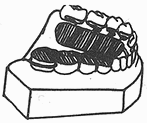| disease | Posterior Crossbite |
Posterior crossbite can occur during the deciduous or permanent dentition period, involving either individual teeth or multiple posterior teeth; it can occur unilaterally or bilaterally.
bubble_chart Etiology
1. Due to early loss or retention of deciduous molars, the permanent upper molars may tilt lingually or the lower molars may tilt buccally, which can lead to individual posterior crossbite.
2. Deep caries on one side, forcing the use of the other side for chewing, can over time lead to unilateral multiple posterior crossbite.
3. Abnormal pressure on one side of the mandible, such as a long-term habit of resting the cheek on one hand, can cause the mandible to gradually deviate to the other side, also leading to multiple posterior crossbite on the opposite side.
4. In patients with mouth breathing, increased pressure on both cheeks can cause the upper dental arch to gradually narrow, leading to bilateral multiple posterior crossbite.
5. Patients with cleft palate often have insufficient development of the width of the upper dental arch, commonly resulting in bilateral posterior crossbite. {|104|}
bubble_chart Clinical Manifestations
Unilateral posterior crossbite or bilateral posterior crossbite may be observed, and it can also be accompanied by anterior crossbite. It affects occlusal function, maxillofacial development, and the temporomandibular joint.
1. Individual posterior crossbite has little impact on masticatory function and jaw development, but may have adverse effects on the temporomandibular joint.
2. Multiple posterior crossbites affect function, maxillofacial development, and the temporomandibular joint.
3. Unilateral multiple posterior crossbites are often accompanied by anterior crossbite, with the midline of the lower incisors, chin, and mandible deviating towards the crossbite side, leading to facial asymmetry. The more teeth involved in the posterior crossbite, the more severe the crossbite, the greater the impact on occlusal locking and masticatory dysfunction, and the more significant the effects on jaw development and the joint.4. Multiple posterior crossbites combined with anterior crossbite result in underdevelopment of the premaxilla, and the facial profile may present a concave shape.
5. Bilateral multiple posterior crossbites often restrict the development of the upper dental arch and maxillary width, leading to a narrow upper arch and a long, narrow facial appearance, but with bilateral symmetry. {|104|}
bubble_chart Treatment Measures
1. Unilateral posterior crossbite can be treated with a maxillary unilateral bite plate appliance (Figure 1). This involves creating a bite plate on the normal side to elevate the occlusion, allowing the crossbite side to disengage from the lock. On the palatal side of the posterior teeth on the crossbite side, a double loop lingual spring is placed. The spring is adjusted to move the upper posterior teeth on the crossbite side toward the buccal side to correct the crossbite. After the crossbite is resolved, the bite plate should be gradually reduced. During the correction process, the patient needs to cooperate with occlusal adjustments, including grinding the lingual cusps of the upper posterior teeth and the buccal cusps of the lower posterior teeth to establish a better occlusal relationship. For individual posterior crossbites, in addition to using a bite plate appliance, fixed appliances on both the upper and lower jaws can be used to perform buccal-lingual reciprocal traction to resolve the posterior crossbite.

Figure 1: Removable appliance for correcting multiple posterior crossbites.
2. Bilateral posterior crossbite or unilateral deep posterior crossbite with the opposite side in normal occlusion indicates a significantly narrow upper dental arch. In such cases, a maxillary split baseplate appliance with bilateral bite plates can be used, along with expansion screws to widen the upper dental arch. On the mandible, bands and a labial arch are placed. During each follow-up visit, the labial arch width is adjusted to reduce the lower dental arch width. Once normal occlusion is established on the opposite side, the maxillary appliance can be modified to a unilateral bite plate, and a lingual spring can be used on the crossbite side to continue moving the upper posterior teeth toward the buccal side to correct the crossbite. After the crossbite is resolved, the bite plate is gradually reduced. During the treatment, occlusal adjustments can be made to facilitate proper occlusion. This treatment is particularly effective during developmental ages. After crossbite correction, masticatory muscle and temporal muscle training can be incorporated to stabilize the correction and establish balanced occlusion. Additionally, a screw-type split baseplate appliance can also be used.




